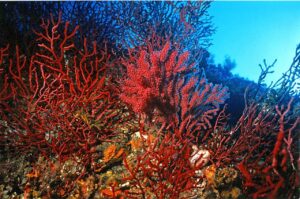 ocean dead zone in the Gulf of Mexico
ocean dead zone in the Gulf of Mexico
Ocean dead zones occur when water loses its oxygen through a process known as deoxygenation.
Agricultural fertilizers are causing this phenomenon. Nutrient run-off from upstream farms and lawns wash off into waterways, and eventually into the ocean. The shortcoming of fertilizers is attributable to their composition, which usually consists of nitrogen and phosphorus elements. These chemical substances are naturally present in our ecosystem and sustain planetary cycling of elements that are indispensable for life on Earth. However, the increased anthropogenic input causes a buildup of these elements in estuaries, freshwater lakes and coastal ecosystems that feeds algae growth. The unlimited growth of phytoplankton alters the food chain and exacerbates the depletion of dissolved oxygen in water: this process is known as eutrophication and leads to inconvenient algal blooms, decreases biodiversity and degrades waterbodies. Oxygen depletion is a result of the bacterial degradation of the plant material – phytoplankton – that sinks and decomposes whilst consuming the oxygen supply present in water. An area with less oxygen dissolved is known as hypoxic zone but is commonly referred to as “dead zone” because is inhospitable for marine organisms.
The impact of nutrient overloading is not limited to water bodies, but it extends to a degeneration of aesthetic and economic values significant to human well-being. Despite hypoxic regions naturally occur, their number, size and duration have been amplified due to anthropogenic nutrient contributions from a variety of sources such as agricultural, municipal and industrial. This phenomenon is striking for marine life but for the economy as well: the fishing and tourism sector usually undergo monetary losses in warmer seasons – spring and summer – when the algal bloom begins. One of the most renown dead zones in the world is the Gulf of Mexico, where the Mississippi and Atchafalaya Rivers discharge and subsurface waters are depleted of dissolved oxygen, failing to support most life, including commercially desirable species. The Gulf of Mexico is a major source area for the seafood industry and supplies 72% of U.S. harvested shrimp, 66% of harvested oysters and 16% of commercial fish (Potash and Phosphate Institutes of the U.S. and Canada, 1999).
Another article you might like: 3 Ways to Reach the UN Goal to Protect 30% of the Ocean by 2030
To mitigate the “dead zone” problem it is important to address the issue at source: reducing use of fertilizers on farmland that results in excessive runoff of nutrients and looking at nature-based solutions that can benefit both the planet and farmers. For example, scientists have addressed the issue by adding vegetation to act as a riparian buffer: four lines of plants that will naturally hold nitrogen in their roots, separating farmland from streams and adding biodiversity to the area. The second strategy to mitigate dead zones lies in restoring river floodplains and wetlands as the native plants include riparian buffers that can act as filter for nitrogen. Moreover, these nature-based solutions can only mitigate the problem and not solve it; companies that excessively use fertilizers on farmlands should take responsibility to decrease their input. Below, link to the petition to ask Tyson Foods to keep their promise and make meat less polluting:
sign petition against tyson foods













